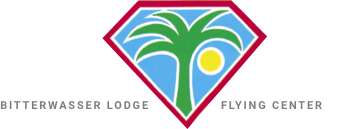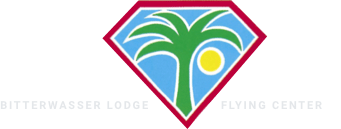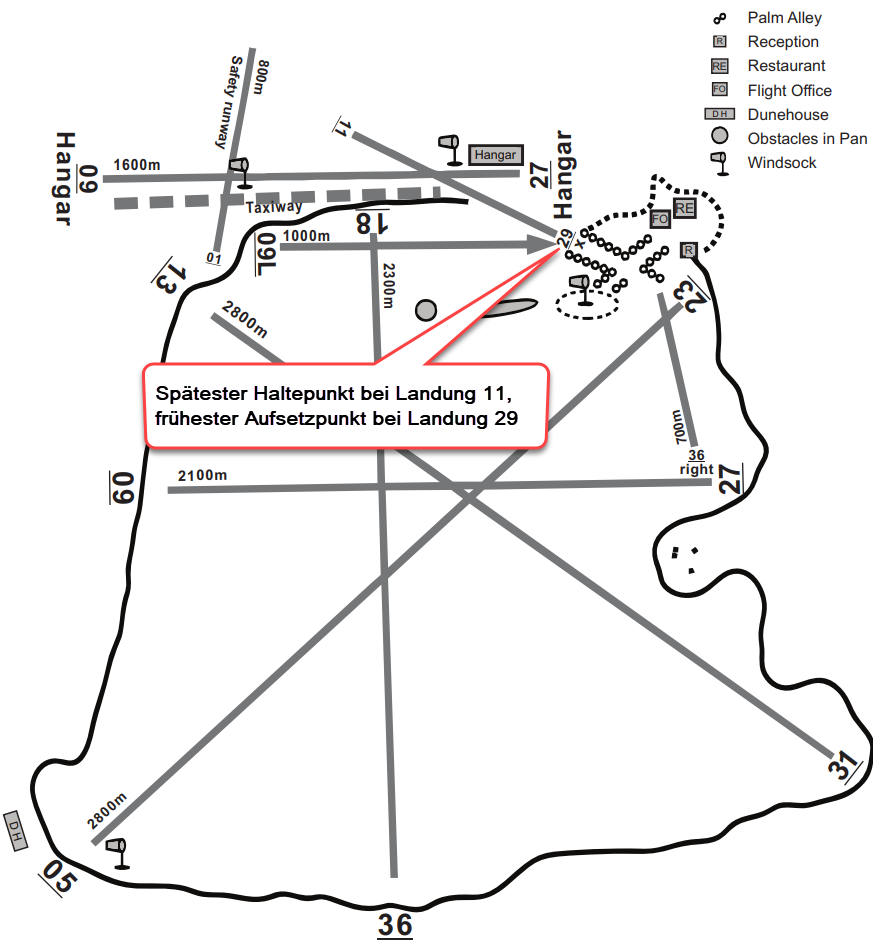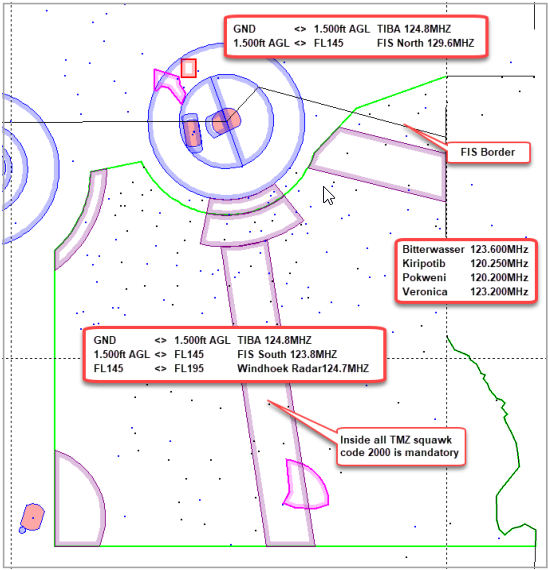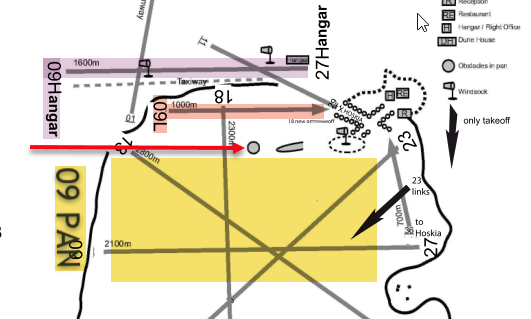Pilot requirement
Information and regulations for pilots
Up-to-date information about airspace is available on the SSN homepage (Soaring Society of Namibia) and at the entry briefing on site.
Requirements
- Language skills: English Proficiency Level 4 is required as PIC!
- SPL license is required (no LAPL)
- Altitude: in feet MSL or flight level, Transition Altitude in Namibia is 10.000 ft - AIP ENR 1.7-1
- We explicitly point out here again that flight level altitudes are always to be flown based on the standard pressure setting at 1013.25 HPa !!!!
- When starting in Bitterwasser with an altitude of 4,140 ft, the altimeter must of course be set to 1013.2 HPa before reaching the FL zones, i.e. before reaching 10,000 ft.
- Decisive is always what the transponder transmits to ATC. We strongly recommend to operate the navigation systems with the altitude in ft.
- For current reasons there is already a SSN directive No. 5 - please read it!
SSN Directive N0. 5 – 2018 – Soaring Society of Namibia
For general comprehensibility and orientation, the Namibian Aviation Administration and ATC require that communication among aircraft and especially with ATC be in English and that units and measurements be expressed in feet, knots, nautical miles and flight levels. Furthermore, it is occasionally necessary to use radials (in degrees) and distance (vectors) for position information in relation to airfields or VORs. We recommend to use the possibilities of today's standard on-board computers and to configure the displays in such a way that you are able to display your altitude in FL or feet at any time without having to convert and to indicate your position in relation to one of the larger VORs in degrees and distance in NM at any time. This is also important for an emergency message or message under stress, in which as many listeners as possible must be able to quickly understand where you are. It is also important to configure your on-board computers for course and direction information in magnetic or declination degrees, since the local declination is 13 degrees west.
Welcome to Bitterwasser
You will find exceptionally good conditions. The weather here is exceptionally good and it is not for nothing that Bitterwasser is considered the "best gliding site of the world" (quote Bruno Gantenbrink after his first stay in Bitterwasser).
Bitterwasser is a privately operated gliding center. Participation in flight operations at Bitterwasser requires overnight stays at the Bitterwasser Lodge. Overnight stays in tents are not possible.
However, flying in Namibia is very different from flying in Central Europe.
This information is intended to help you make your stay in Bitterwasser as pleasant and, above all, as safe as possible.
Flying in Namibia- what is different?
Never without oxygen!
The base altitudes in Namibia are much higher than in Europe. They are about 4500-5000m or even more. This is one reason for the fast cuts in Namibia, but then oxygen must be used at these altitudes! Therefore all airplanes flying in Bitterwasser have a working oxygen system. The bottles can be refilled every day. It is therefore recommended to bring an oxygen cannula with you to Bitterwasser, but of course some can be purchased in the flight office.
Fuel- enough for a long flight home!
Normal, long flights sometimes take you 200-300km or more away from Bitterwasser. Therefore, it must be remembered to count on enough fuel for such long flights home and refuel daily if necessary. Often the flight home is against strong winds. Avgas and Mogas are always available in Bitterwasser.
Radio communication - rules must be observed!
Radio communication in Namibia is in English. Most of the time we don't have to use the radio much, since we are almost alone in the airspace that has been specially cleared for gliding, but English Prof., minimum Level 4 is required. Since our flight area is very large, position reports should be sent every now and then. For your safety it has been introduced in Bitterwasser that every glider gives a position report one hour before sunset. (This is controlled)
Start list- Always register!
In the morning, everyone enters their name in the takeoff list independently. In the evening, the Chief of Flight Operations (CFO) enters the position reports and checks them off so that it is noticed as quickly as possible if an aircraft is missing.
SPOT Tracking and Emergency Transmitter
The SSN (Soaring Society of Namibia) prescribes to use a SPOT and to deposit the link in the flight office. This is absolutely recommended to increase safety in case of emergency!
Mandatory Spot Tracking - Soaring Society of Namibia (ssn.org.na) LINK
Day of arrival:
In Namibia, daytime temperatures can rise to 40° Celsius during the season, but it is a dry, pleasant heat. However, this sometimes extreme temperature difference affects our bodies and therefore it is not possible to fly as a responsible pilot on the day of arrival. We ask to respect this for safety reasons.
Tip drink a lot of water!
Formalities - before the first flight:
All pilots flying or riding in an aircraft in Bitterwasser must be members of the Bitterwasser International Flying Club (BIFC). They must therefore sign the BIFC Membership Declaration and the BIFC General Liability Disclaimer prior to their first flight in Namibia (whether it is a glider, powered flight or passenger flight in one of our aircraft).
Membership in the BIFC does not include any insurance. The pilot or person causing damage during activities on the ground and in the air is responsible and liable. In particular, the BIFC cannot be held liable for it.
Current training / Start types / License
The current legal provisions for German licenses apply:
- 5 hours of flight time as a pilot in command including 15 takeoffs.
- Two training flights with an instructor rating.
- 5 takeoffs per takeoff type.
- Flights with passengers: in the last 90 days 3 take-offs on the respective aircraft type.
Attention self-starters!!! - no launches on touring motorgliders are valid!
Self launch authorization: 5 launches with flight instructor and 5 solo launches.
We recommend a total flight experience of at least 500 hours, but it is more important to have flown mainly in the last two years. Of course, there is always the possibility of appropriate briefings and flights with an experienced flight instructor on site. In Bitterwasser there are currently only self launchers. Aircraft chartering is therefore also only possible with appropriate experience as PIC.
A very good way to experience the beauty and adventure of Bitterwasser is also:
Flying with the Youngsters Link
Please present your original flight logbook, certificate, medical etc. at the flight office, preferably confirmed for the arrival briefing. On the day of arrival no flight as PIC is possible. In general, each pilot must first report to the flight office and do the "paperwork".
Please send your licenses with Medical scanned, preferably already before your vacation to Bitterwasser. Mail: flightoffice(at)bitterwasser.com
Aircraft owners please send the:
Registration Certificate,
proof of insurance
current annual inspection
also in advance to this address.
If you want to use a Namibian registered aircraft, then you need a validation of your license. This must be applied for early enough (7 weeks before your stay in Bitterwasser) to be available in time for your arrival. Of course we will assist you with the validation.
Aircraft that are not Namibian registered need a Namibian overflight permit, this will be applied for by us and if fees are due, the owner will be charged.
Rescue kit/equipment
For cross-country flights, please note that they fly over the desert and in sparsely populated areas, and they may also have to spend the night in the desert after an outlanding before they can be retrieved. For such flights you should at least take the following equipment either on your man or better attached to your parachute:
- min. 2l water per person.
- Bad solution: water in the wings may not drain completely, not suitable for drinking, possibly boil. Container to collect the wing water is necessary.
- a flashlight
- an aluminum blanket.
- signal rockets
- band-aids and signal mirrors
- lighter or matches
- warm clothing
- possibly a mirror
- candy`s against dry mouth
- whistle
An appropriate kit (without water and warm clothes) can be rented in Bitterwasser. Do not forget your personal documents, a phone card, cell phone (though rarely work) and some money.
A tracking system like SPOT is mandatory per every pilot! - The spot must be attached to the pilot or to the parachute - we ask for your attention!
Furthermore we offer satellite phones for rent, these are available in the flight office and can be booked before departure.
Flarm
Flarm is a matter of course and required for all gliders in Namibia by the SSN. We need the FLARM ID from every glider. Since the season 2015/2016 OGN receiving systems are installed on all airfields. This is for additional safety. Please assist the Flight Office team in communicating the FLARM ID.
Important phone numbers for you:
(please always check or ask for cell phone no. again beforehand).
Handy Flight Office: +264 813030393
Phone Bitterwasser: +264 833265300
Pokweni +264 63265608
Kiripotib +264 62581419
Air Traffic Control: +264 6270249094
Accident Hotline +264 612088410
Please print these numbers or carry them in writing with you on each flight in case of emergency.
Ground operations
Vehicles:
Vehicles are available for transporting aircraft on the ground (sometimes with driver and helper). These vehicles must be parked in front of the Flight Office between 22:00 and 07:30 when not in use and the vehicle keys must be handed in at the Flight Office. It is unfair to the other guests to leave these vehicles overnight in front of the bungalow or in the pan after take-off. Unnecessary travel across the pan, especially with towed aircraft - is to be refrained from in the interest of flight safety.
In order to protect the surface of the pan and your dolly wheel, only tow bars where the dolly wheel does not roll on the ground are approved.
Important! Only such tow bars are allowed in Bitterwasser.
Aircraft must be towed slowly, exclusively on the pan edge and on the designated paths, carefully by car to the starting point.
Once an aircraft is attached, the pilot himself drives the passenger car! - Nevertheless, our lineboys, mostly long-time employees, are very experienced. Therefore, please follow their advice when retrieving from the pan regarding the driving rod - crossing the runway is to be avoided!
Parking areas for gliders:
These can be fixed in the palm alley or on the southwest outside of runway 11/29 with the nose facing northeast or in front of the bungalows. The parking areas have electricity and water connections (Attention! No drinking water!). Parking areas for motorized aircraft will be assigned by the air traffic control. It is forbidden to taxi in the palm avenue with motor airplanes and motor gliders with own power.
Furthermore, we urgently ask you to observe:
When landing on 11, called Hoskia, the aircraft must come to a stop in front of the first bungalow. Taxiing out to the bungalows through the palm avenue is prohibited because of the passenger traffic there! Accordingly, when landing on 29, the touchdown point must be chosen after the bungalows. Flying through the palm avenue is also strictly prohibited! Furthermore, the aircraft should come to a stop in front of the runway 09/27 HANGAR. There is no taxiing within 100 meters of the main windsock in front of the palm avenue. The ground there is very soft.
Starting procedure:
The flight operations management at Bitterwasser is responsible for the safe operation of the airfield. The instructions of the Chief of Flight Operations (CFO) or his assistant must therefore always be followed. Please also follow the departure and approach procedures accordingly.
Prior to take-off, planned FAI - and record flights must be confirmed by a Namibian licensed sport witness with a declaration form!
Engine power:
Please note that due to the altitude and temperature the performance of your engine is no longer comparable to the performance in Central Europe, but is much worse and you will need a correspondingly longer take-off roll.
Takeoff direction:
This will be determined at the briefing, if possible, but can change situationally (wind direction usually changes significantly during the day). With the available or your car you pull your airplane at the edge of the pan to the given starting point. Since we cannot provide a car for every aircraft, out of consideration for the waiting pilots, we ask you to ensure that the vehicle returns from the starting point as quickly as possible to fetch the next one. - Selfishness is out of place here!
The starting line-up:
Due to the size of the Bitterwasser pan, you can line up side by side. Check your airplane calmly before takeoff and when you are ready for takeoff, report on the field frequency with license plate number and takeoff direction and the notice that you will take off in 2 minutes. Preferably without the engine running because of communication. Please wait for a confirmation.
If there is a high volume of aircraft, the takeoff procedure will be coordinated by the on-site flight operations control, and confirmation will be made by radio for individual takeoffs.
Please note that at take-off direction 09 and 13 on the opposite side the pan jumps in like a peninsula and there the take-off distance is shortened!
After take-off: At every take-off without exception a left turn is to be flown, the climb flight is along the edge of the pan, thus in case of an engine malfunction it is always possible to land safely on the pan! Within a radius of 10nm around the pan only left hand cranking is allowed!
During the flight
Within 20 km / 10 NM around the pan, the bitter water frequency must be locked and listened to.
The current information on: http://ssn.org.na (Flying in Namibia) LINK
Radio discipline procedures around Bitterwasser and Windhoek.
Only English must be spoken on the radio. Radio is a safety aspect that benefits everyone. Most pilots in Namibia speak English and are used to giving position reports in uncontrolled airspace.
They expect the same from us glider pilots. We show a bit of professionalism when we comply as well.
In the TMA/CTA Windhoek the special usual procedures apply and this of course also only in English. An entry into this airspace can only be made by clearance from the controllers. Entering without radio contact is forbidden, irresponsible and can lead to the revocation of your license and even worse can call into question the entire authorization of gliding in Namibia!!!
We are guests in this country where gliding plays such a subordinate role that we would do well to abide by the law. - Where else can you fly so carefree, without big airspace restrictions? By the way, common sense applies on the radio as always. Keep communication as concise and concrete as possible and listen when others are talking and need help at best.
Frequency for the Glider Area:
From ground to 1.500 ft AGL -> 124,800 (TIBA)
1500 ft to FL 145 -> 123,800 (FIS South)
FL 145 to FL 195 -> 124,700 (WDH Radar)
Gliders shall not enter controlled airspace (except emergency with radio contact).
Scheme of a position report:
“I P T A N” Schema
I- Identity Callsign
P- Position
T- Time / Zeit
A- Altitude / Height in feet at standard pressure 1013 and whether rising or falling
N- Next – What is the next destination - waypoint or cardinal direction
Example in the area FIS SÜD:
Traffic on 123.80. This is D-KDEE, 5 Miles west of Mariental at this time at 10400 feet descending, Flying in a north direction towards Bitterwasser. Conflicting traffic please respond to D-KDEE, west of Mariental, flying northwards
or
Traffic on 123.80, This is D-KDEE. I am on radial 235, 78 miles of the Windhoek VOR at this time at 10400 feet descending. Flying in
a south-easterly diretion towards Bitterwasser. Conflicting traffic please respond to D-KDEE, Radial 235, 78 Miles, flying southeast.
We will respond to reports from motorized aircraft if we are within 25 miles (46.3 km) of their position. Please make these reports once more rather than once too little!
Windhoek FIS has two frequencies:
one north of the gliding zone 129.60 and
one in the Gliding Zone, so south 123.80.
Again to repeat - within the Gliding Zone at altitudes from 1500ft AGL to FL 145 this FIS South (123,800) is to be used.
From FL 145 to FL 195 then the 124.700 WDH radar.
TMZ – observe:
Transponder on FL 145 to FL 195 / Squawk 2000 / Freq. 124.700
Attention exception:
TMZ Kiripotib FL 100 to FL 145 / Squawk 2000 / Freq. 123.800
We ask strictly for attention and in case of ambiguity for consultation with the flight office!!! Better ask once more than 1 x too little.
Details about the airspace can be found on the homepage
Airspace - Soaring Society of Namibia (ssn.org.na) LINK
Position report: 1 hour before sunset
Experience has shown that it makes sense for all pilots still flying to send a position report to Bitterwasser on the airfield frequency 1 hour before sunset.
This way the flight operation management knows that they are on their way back or that everything is alright, if not appropriate measures can still be taken in time before Sunset. If you do not reach Bitterwasser, go to frequency 123.80 or 124.700 and ask another aircraft to transmit your message!
SUN SET:
At the briefing, the daily SUN SET time is issued. This time is the official operating time of Bitterwasser. It is up to each responsible pilot to use the additional 15 minutes at his own risk. From the 16th minute on, a landing counts as a night landing!!! Flights with night landing are not valid and must not be entered into the OLC! If this regulation is not observed, Bitterwasser reserves the right to also issue flight bans!
Landings at night are very dangerous and forbidden by law. Nevertheless, if you realize for any reason that it will be a night landing, then report this early to the flight control.
Approach and landing in Bitterwasser
Please expect that the light, uniform sandy ground will initially take some getting used to for some pilots in terms of proper interception.
Once they are 10 NM from Bitterwasser, rest the airfield frequency and make a position report with altitude course and intent.
Example: (abbreviation)
PE 10 NM West of Bitterwasser, altitude 8500ft, heading 083, for landing
You will get the existing wind direction and if possible the wind strength from the air traffic controller or you simply ask for it again.
If there is no or very little traffic, you can choose the landing direction yourself in consultation with the other approaching pilots, but of course you must inform them by radio. In case of heavy traffic the flight director will give the landing direction. If instructions are given by the air traffic controller, these must be followed.
Important - please report any position in the aerodrome circuit! (downwind/base/final)
Standard approach from the west:
Most of the time, due to the low sun and if wind strength permits, we like to land in an easterly direction. Then the standard procedure is as follows:
- 1st message 10 NM - PE 10 NM West of Bitterwasser, altitude 8500ft, heading 083, for landing - from Bitterwasser you get wind direction and strength and you decide for 09 landing direction or get 09
- 2. message PE 5NM for landing 09 left - you fly from the west in a wide left circle around the pan until you have reached the appropriate altitude for the counter approach.
- 3. message PE downwind 09 left gear down and locked - you continue flying straight ahead and just before the dune you turn into cross approach
- 4. message PE base 09 left - you fly into the final part and report
- 5. message PE final 09 left
(corresponding to 09 Hangar and 09 Pan or corresponding to other directions)
For the landing direction 09 there are even three possibilities:
09 HANGAR - 09 LEFT and 09 PAN
on 09 Pan several aircrafts can land well in parallel, there is enough space.
(red arrow shows the row of bushes on the pan, everything south of it corresponds to 09 PAN).
Attention:
If it rains or the pan is wet, only the 09/27 HANGAR runway is used. This is appropriately paved and therefore can be used well even when there is a lot of rain.
The current approach procedures, landing directions and special features will be explained in detail during the briefing. Only these apply!!!!
In case of an outlanding:
In case of an outlanding, it is imperative to transmit the position as soon as possible, preferably shortly after the decision to make an outlanding! In case of an outlanding, please remember to report to Bitterwasser or one of the other flight centers or via radio as a transmitter, so that we know where you are! Make sure SPOT with tracking is properly turned on and able to transmit.
123.80 / 129.600 MHz (FIS South/North) rest and try to inform others about it and inform in relay Bitterwasser about it in case of no reception
124.70 MHz rest (Windhoek radar) or other aircraft if no reception
126.90 MHz TIBA frequency rest, relay position via airliner and importantly also tell pilots where to relay message - Windhoek etc.
or
121.50 MHz use emergency frequency
During approaches from unmanned aerodromes on the frequency 124.80 MHz give obligatory messages. (downwind, base, final)
Important. When you leave the aircraft after the outlanding, be sure to take your SPOT with you in tracking mode and make sure it sees clear sky. This way you can be found.
Documents
Bitterwasser now scans all documents. You make the administrative work easier for us and for you if you provide us in advance with your medical, your certificates, your radio communication certificate as a PDF document. Please send this early to Info@bitterwasser.com
Important: Validations are only required for Namibian registered aircraft. If you have chartered a D registered aircraft, then you only need all the usual documents as in Germany.
Validation:
7 weeks before your first glider flight in Namibia the application should be submitted!
We are happy to help you with the application
Medical:
You need a valid, JAR-FCL3 compliant medical (medical certificate). LAPL medical is not sufficient. The document must also be readable in English (usually it is multilingual in English and the local language). Important, your medical must not expire during your vacation! If your medical is only issued in German, it must first be checked by a Namibian medical officer of the aviation authority at a charge. Please make sure that the complete address of the examining physician, with telephone number, is clearly legible on it. (there are also queries from Namibia). The corresponding examination is carried out in Switzerland by medical officers of the FOCA.
